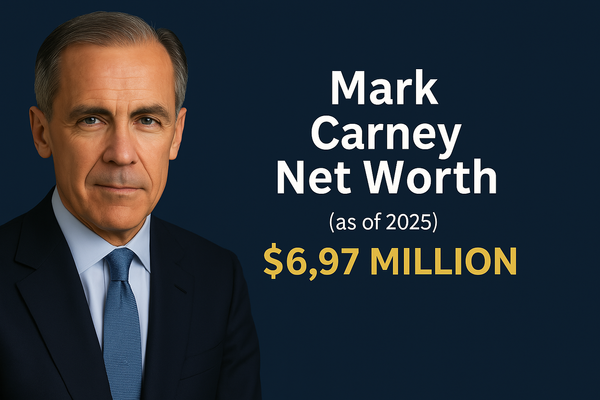Mark Carney Platform Explained: What Voters Need to Know in 2025
Mark Carney's platform has pushed the Liberal Party's support from 16% to 42% in recent polls, putting them ahead of the Conservatives at 36%. Carney brings a unique experience in crisis management to his political goals. His background as Governor of the Bank of Canada during the 2008 financial crisis and the Bank of England during Brexit speaks volumes.
His platform stands out with its all-encompassing approach to Canada's urgent challenges. The proposals include a 1% income tax reduction for earnings up to CAD 57,375. He plans to eliminate the consumer carbon tax and remove GST for first-time homebuyers on properties under CAD 1 million. His role as the UN Special Envoy on Climate Action and Finance has helped him create a unique environmental policy that balances economic needs.
Our detailed analysis will get into the core elements of Mark Carney's platform. We'll break down his proposed solutions for Canada's economy, climate policy, housing crisis, and international relations as the Liberal leadership election approaches in March 2025.
Mark Carney's Economic Vision for Canada
"By working together, we can expand and build one more interconnected and resilient Canadian economy. Canadians are ready to show the world that we can cheer for different teams and still be one strong team when it counts." — Mark Carney, Prime Minister of Canada
Mark Carney's platform features a complete economic strategy that wants to restore fiscal discipline and accelerate growth. His approach represents a clear move from previous Liberal policy and focuses on targeted spending cuts among strategic investments.
Tax cuts and middle-class relief proposals
The tax reform in Carney's plan centers on a one percentage point reduction in the lowest income tax bracket. This change would benefit over 22 million Canadians. His middle-class tax cut would put up to CAD 1149.52 back into the pockets of two-income families annually. The greatest benefits would flow to middle and low-income earners. The platform also promises to scrap the previously proposed capital gains tax increase, which would create a more investment-friendly environment.
Carney has pledged a different path from his predecessor's policies: "My new government will focus on helping hard-working Canadians keep more of their paychecks to spend where it matters most: on homes, groceries, and their families".
Strategy for handling U.S. tariffs and trade tensions
Trade tensions with the United States have escalated. Carney supports "dollar-for-dollar retaliatory tariffs aimed where they will be felt the hardest in the United States but will have the least impact in Canada". He recognizes practical limitations and notes that "there is a limit to matching these tariffs dollar for dollar given the fact that our economy is a tenth the size of the United States".
Carney's proactive approach extends beyond reactive measures and includes:
- A national trade strategy with optimized corridors
- Complete removal of federal barriers to interprovincial trade by July 1, 2025
- New partnerships in Europe, Asia, Latin America, and Africa
Deficit reduction and government spending plans
The life-blood of Carney's fiscal approach separates federal operating and capital budgets. His government would "balance the operating budget in three years through responsible financial management". A "small deficit on capital spending" would continue for infrastructure, clean energy, and defense.
Carney promises to curb government spending growth, cap the public service's size, and utilize technology to reduce inefficiencies. His commitment preserves transfers to individuals (pension benefits, EI, child benefits) and provinces (health transfers, equalization).
Investment attraction and economic growth targets
The investment strategy uses "scarce public investment dollars" to "catalyze multiples of private investment". Growth initiatives include:
- Canada's transformation into a "clean energy superpower" requiring CAD 111.47 billion in annual investments until 2050
- Reduced red tape for housing construction
- Canada's positioning as a reliable supplier of critical minerals
- Elimination of interprovincial trade barriers, potentially adding CAD 348.34 billion to Canada's economy
Carney plans to reduce "inefficiencies" by utilizing AI across government operations while maintaining essential services.
Climate and Energy Policy Shifts
Mark Carney's platform introduces the most important changes to Canada's climate policy. His approach creates a balance between environmental goals and economic common sense. These changes mark a complete break from the Liberal party's previous climate strategies.
Elimination of consumer carbon tax
Mark Carney signed an order eliminating the consumer carbon tax (fuel charge) effective April 1, 2025 as his first act as Prime Minister. This bold decision removes a policy that Carney called "too divisive". Canadian citizens will receive their final rebate payment in April 2025. The change will lower gasoline prices by 17.6 cents per liter and natural gas by about 15 cents per cubic meter.
Industrial emissions approach and border adjustments
Carney's platform strengthens the industrial carbon pricing system for large emitters instead of abandoning climate action. His strategy improves the Output-Based Pricing System (OBPS) to reward companies that cut their emissions more effectively. The burden now falls on major polluters rather than consumers. The plan also develops a Carbon Border Adjustment Mechanism that adds tariffs on imports from countries without similar carbon pricing. This affects steel, chemicals, cement, and aluminum sectors mainly.
Clean energy infrastructure investments
Carney wants to make Canada a "clean energy superpower." This vision needs annual investments of CAD 111.47 billion until 2050. His strategy targets key sectors:
- Nuclear and hydropower infrastructure
- Wind and hydrogen technologies
- Battery storage solutions
- Carbon capture technologies
The plan speeds up clean energy project approvals and reduces regulatory barriers to boost development.
Oil and gas sector policies
In stark comparison to this, opposition claims about production limits are wrong. Carney confirmed he will keep an emissions cap—not a production cap—on the oil and gas sector. He focuses on boosting investments in carbon capture technology and methane reduction. "The regulation or a law doesn't reduce emissions," Carney stated, showing his preference for practical solutions over regulatory frameworks. This stance tries to protect Canadian energy production and exports while meeting environmental goals.
Housing and Cost of Living Solutions
Mark Carney's 2025 platform puts solving Canada's housing affordability crisis front and center. His plan has targeted steps to help more people buy homes and speed up construction across the country.
GST exemption for first-time homebuyers
Carney wants to remove the Goods and Services Tax (GST) for first-time homebuyers on properties under CAD 1.39 million. This tax break would save buyers up to CAD 69,668.01 on new home purchases. "We must ease the financial burden on young Canadians and help them catch up and enter the housing market," Carney stated. This exemption would make homes more affordable and motivate builders to increase supply.
Housing construction acceleration plans
Canada's severe housing shortage has pushed Carney to pledge doubling new home construction over the next decade. The country builds about 227,000 homes each year now, but his plan targets 454,000 homes annually to deliver 4 million new homes. This bold goal depends on "catalyzing enormous private investment" and new building methods. Carney backs the growth of prefabricated and modular housing industries. These techniques can cut down building time and costs through volumetric modular construction.
Immigration caps and housing supply connection
Yes, it is clear that Carney links immigration policy directly to housing availability. He promises to "cap immigration until it can be returned to a sustainable trend". This makes sense since Canada's population grew by 3% yearly between 2021-2024, twice its usual rate, which put pressure on housing supply. "We had much higher levels of foreign workers, students, and new Canadians coming in than we could absorb," Carney explained. These caps will "remain in place until we've expanded housing", showing how population growth and housing development must work together.
Affordability measures beyond housing
Carney's platform has cost-of-living solutions that go beyond housing. His government would "reduce spending while improving its effectiveness", which could free up money for housing investments. He also promises to help First Nations, Inuit and Métis peoples with housing by "advancing solutions that respond to local priorities". Canadian families face rising food costs—expected to jump by CAD 1,116.08 for a family of four in 2025. These combined steps aim to make life more affordable on several fronts.
Defense and Foreign Policy Positions
"We will never, ever, in any way, shape, or form, be a part of the United States. America is not Canada." — Mark Carney, Prime Minister of Canada
Mark Carney's defense strategy focuses on strengthening Canada's military capability and asserting its sovereignty, particularly in the contested Arctic region.
NATO spending commitments
NATO allies have long pressed Canada to increase its defense spending. Carney promises to meet NATO's defense spending standard of 2% of GDP by 2030. This new timeline comes two years earlier than the previous government's 2032 commitment. Canada currently spends about 1.37% of GDP on defense, making it one of nine NATO allies that fall short of the alliance's standard. The Liberal Party's potential victory in April's election would bring what Carney calls an "unprecedented acceleration of investment" in Canada's armed forces. This move would help Canada meet its international obligations as global security continues to evolve.
Arctic sovereignty initiatives
Arctic security serves as the life-blood of Carney's platform, backed by major investments. His government has pledged over CAD 8.36 billion to develop Canada's Arctic Over-the-Horizon Radar system with Australia. Additional funding of CAD 585.21 million will establish a "greater, sustained and year-round" Canadian Armed Forces presence throughout the North[194]. The strategic collaboration with Australia will enhance radar technology that provides early warning and long-range surveillance capabilities. This technology will detect threats in Northern approaches more quickly. Carney wants to "defend every inch of our sovereign territory" through expanded military operations and more personnel.
International relations approach
Carney's international strategy works to rebuild relationships with traditional allies beyond the United States. Recent visits to France and the United Kingdom have focused on deepening economic, commercial, and defense partnerships. This approach broadens Canada's international connections. While Carney states that Canada "will not be in any way part of the United States", he recognizes the value of North American defense cooperation. This cooperation includes joint projects like the Icebreaker Collaboration Effort with the U.S. and Finland.
Defense industry investments
Carney plans to redirect defense spending toward Canadian industries rather than sending "dollar after dollar south of the border". His platform promises new submarines, "first class drone capability," and more heavy-duty icebreakers. The military faces a 14,500 personnel shortage, which he plans to address through better recruitment methods, military pay increases, and improved on-base housing and services.
Conclusion
Mark Carney's detailed platform tackles Canada's most urgent challenges with practical solutions rather than ideological stances. His economic strategy balances tax relief with fiscal responsibility. His climate policy focuses on industrial solutions instead of consumer penalties.
The housing crisis gets special focus through specific measures like GST exemptions and faster construction plans. His defense commitments make Canada stronger globally, particularly in Arctic sovereignty and NATO obligations.
Some proposals might be hard to implement. However, Carney's track record of managing complex crises at the Bank of Canada and Bank of England shows he can execute bold reforms effectively. His platform charts a middle path between high spending and deep cuts. He focuses on strategic investments and targeted relief measures instead.
These proposals' success ended up depending on how well they're executed and Canada's economic situation after the 2025 election. Carney's detailed approach offers clear answers to Canada's current problems while being fiscally responsible.
FAQs
Q1. What are the key economic proposals in Mark Carney's platform? Carney proposes a 1% income tax reduction for earnings up to CAD 57,375, elimination of the consumer carbon tax, and a plan to balance the operating budget in three years while maintaining a small deficit for capital spending on infrastructure, clean energy, and defense.
Q2. How does Carney's platform address the housing crisis? Carney plans to eliminate GST for first-time homebuyers on properties under CAD 1 million, double the pace of new housing construction to 454,000 homes per year, and temporarily cap immigration until housing supply can catch up with demand.
Q3. What is Carney's approach to climate and energy policy? He proposes eliminating the consumer carbon tax while strengthening the industrial carbon pricing system for large emitters. Carney also plans significant investments in clean energy infrastructure and aims to transform Canada into a "clean energy superpower."
Q4. How does Carney's platform address defense and foreign policy? Carney commits to reaching NATO's defense spending target of 2% of GDP by 2030, investing over CAD 8.36 billion in Arctic security initiatives, and strengthening relationships with traditional allies beyond the United States.
Q5. What sets Mark Carney's platform apart from previous Liberal policies? Carney's platform marks a shift towards more fiscal discipline, practical climate solutions, and a stronger focus on housing and cost of living issues. His approach balances tax relief with strategic investments and emphasizes Canada's sovereignty and international standing.


